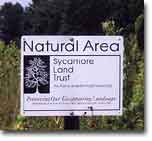![]()
![]()
![]()
![]()
![]()
![]()
|
|
 Sycamore Land Trust: Working to Preserve Endangered Landscapes of South-Central Indiana Sycamore Land Trust: Working to Preserve Endangered Landscapes of South-Central Indiana
One of Southern Indiana's greatest features is the beauty of its landscapes. Many of us who choose to make this our home have traveled throughout the country and even the world, and have found that it really doesn't get any better than this. People everywhere have probably at some time watched with sadness as favorite landscapes, or their old “stomping grounds” have given way to buildings or parking lots. While most of us realize that development is inevitable and often benefits society, we also hope to keep some of our landscapes intact for future generations. You may have heard of the Sycamore Land Trust, a nonprofit group that is working to preserve green space in South Central Indiana. After ten years of working at this goal, they recently hired their first paid staff person, Christian Freitag, to help expand their efforts. We recently met with Freitag, their new Development Director, to learn more about land trusts. Sycamore Land Trust (SLT) feels that the community is ready to start setting aside more green space areas and keeping them natural. While they are not against development, their philosophy is that along with it some proportional amount of land should be set aside as green space. These areas can be set aside in the form of farmland, urban green spaces in cities, forests, grasslands, or even wildlife preserves, depending on the nature of the land. They ensure preservation of these areas by actually owning the land. “We preserve land the old fashioned way - we own it”, board member Steve Howard has said. SLT now owns around 750 acres in Monroe, Bartholomew and Orange Counties, and is hoping to double that. Around 70% of the land has been donated and 30% has been purchased by SLT. “There's no catch here,” says Freitag. “We pay property taxes on the land. We raise the money and buy the land outright. The American dream is ownership of land. We do what we want with our land, which is preserving it, setting it aside, and actually improving it. In some instances that's planting trees or removing exotic species. We're very good stewards of the land.” He also emphasizes that SLT is not a political organization, and does not try to influence other land owners on what to do with their land. Freitag showed us an example of one of the properties that SLT has in Monroe County, called the Bean Blossom Bottoms. This area is what he calls “one of our crown jewels”. In all, around 300 acres are preserved not only by SLT, but by the U.S. Fish and Game Department and other land trusts. This type of ecosystem is called bottomland hardwoods, and is one of the most threatened ecosystems in the country. Bean Blossom Creek runs through, which floods at times and provides a home to one of Indiana's largest Great Blue Heron rookeries. Much of the land is wetlands with intermittent streams, and bottomland hardwood forests. Many such areas have disappeared, having been logged, or drained to create farmland.
Bean Blossom Bottoms in Monroe County Not every piece of property SLT owns is destined to be a wildlife habitat. Each parcel of land is considered individually , and if a land owner is considering donating land, they will work with the individual or family to come up with a plan they are happy with. In some cases that is planting trees. In others, such as a property in Bartholomew County, the property is farmed. Getting Involved There are several ways people can get involved. One obvious way is to actually donate land to Sycamore Land Trust. A landowner who wants to ensure that their property will never be developed can donate land and see a tax advantage, since SLT is a 501(c)(3) nonprofit organization. Freitag explains another option for landowners is to sell it to a nonprofit land trust at a bargain price. “The difference between appraised and sale price is a tax write-off”. Placing a “conservation easement” on a property means the landowner gives up development rights through a contract with the trust, and the trust has the responsibility to enforce that the land be kept natural. Freitag explains, “A conservation easement actually decreases the value of the land because it can’t be used for development”, so this can lessen the tax burden of the heirs. Some folks may not be land owners but would still like to help either Sycamore Land Trust or other like-minded land trusts. A way to do this is through membership. Right now SLT has around 350 members, with the cost of membership being just $10 for students and $25 for families. While the dues don’t cover the high cost of land, they do help run the operation, and most of their active volunteers are members. Volunteers can be involved in lots of ways. These are the folks who get out and do most of the actual work - removing exotic and invasive species, planting trees, operating booths at fairs, and just spreading the word. Other Southern Indiana Land Trusts Until a few weeks ago I had never heard of the Sycamore Land Trust, or any land trust for that matter. I learned from talking to Christian that land trusts are one of the fastest growing conservation techniques in the country. He explains they appeal to a broad range of people because so many people are disheartened at the disappearance of natural areas. They don’t try to tell people what to do with their property, they just work to preserve their own. They pay property taxes and abide by local, state and federal laws. Just a few months ago Freitag and a comrade, Rod Goforth, founded the Ohio River Conservancy. This is a fledgling land trust, having just received their 501(c)(3) status. They don’t own any property at this point, and are working slowly to develop a plan. The Ohio River Conservancy plans to have a slightly different focus, with habitat protection, environmental education and development of urban green spaces as their three branches. Other land trusts in Southern Indiana are the Buffalo Trace Land Trust in Martin County, whose mission, he says, is primarily farmland preservation. Another new land trust has been created in the Evansville area called the Robert Dale Owen Land Trust, which preserves urban green space within the city of Evansville. While Southern Indiana prospers and grows, we are happy to know that there are people devoted to preserving the natural beauty that still surrounds us. For more information on The Sycamore Land Trust see www.slt.org. For information on the Ohio River Conservancy or Sycamore Land Trust call 812-336-5382 or email [email protected]. |

|
All Feature Articles, artwork and photographs ©2000 by Southernin.com. Some information on the 'County Info' pages is taken directly from brochures published by Visitors Bureaus and Chambers of Commerce.